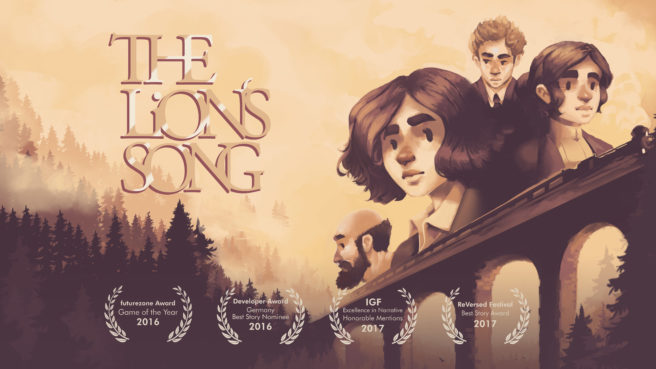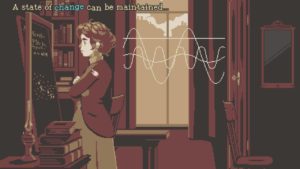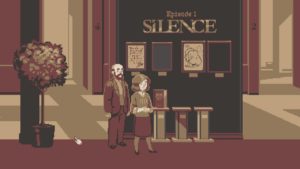
I’ve loved games ever since I was a child, but as games have changed over the years one of my absolutely favorite genres has become narrative games. These games may not be the most game-y games, sure, but they make up for it with stories that are so much more powerful than other mediums through allowing the player to make important choices while taking on the role of the main character. After years of adoration for Telltale Games, it’s very difficult to find a title that’s as emotionally charged and exceptional as their titles are. It was thus with some trepidation that I dove into The Lion’s Song, a four-episode series of point-and-click narratives that all come together.

I reviewed The Lion’s Song on Switch where it comes as a single package for only $10 MSRP, and there’s no wait between episodes as all of them are released. The first three episodes cover three different characters from their point of view, and then the fourth, aptly titled “Closure”, uses a fourth character to go through the first three a bit more in a unique way all while telling a story of his own. The stories are set in Austria in the early 20th century, and each episode stands alone despite some interesting crossing over between them. There are also some real people referenced and utilized in the game, such as Sigmund Freud and Gustav Klimt (a famous symbolist painter).
The first thing that surprised me was the art style, which initially reminded me of stylized old-school portable game graphics. The next surprise was just how effective those graphics were, and I was amazed that they managed to evoke such powerful emotions. This is largely due to both the terrific writing (yes, even the math puns) and the spectacular music in the game. The music is woven throughout the game, it lifts your spirits some moments and it smashes your heart in just the right way in others.

The Lion’s Song kicks off with “Silence”. “Silence” tells the story of Wilma, a composer and violinist who dreams of a relationship with her professor, and who has been sent away alone to his cabin to focus on writing her next piece. She has only a week until a major concert, and between the pressure, a crazy storm, and struggling with figuring out who she is she has a lot to deal with. Dealing with ignoring the loud noises and finding inspiration is far more unique and interesting than it sounds, and I was taken aback by just how well the game worked with the majority of her actions being in half of a screen.

Episode two is “Anthology”; it follows Franz, a portrait artist who can see the layers of a person. Unfortunately, he’s not quite able to create a masterpiece. Not only does he always feel like something is missing from his work, he ends up sporadically blacking out and losing time. When an art critic comes by and critiques his work fairly but bluntly, he feels even more pressure to find out what’s going on with his blackouts and what’s missing from his art.

The third episode, “Derivation”, is probably my favorite by just a hair. “Derivation” is about Emma, a female mathematician in an era when women mathematicians were a joke. She wants nothing more than to complete her theory about change, but she’s stuck. She goes to the Radius Club to meet with a mathematician she’s been writing to, but when he and the others see a woman come to the club they laugh her out. She decides to use her recently deceased father’s clothes to become Emil, and Emil is welcomed into the Radius club with open arms until his theories threaten to overshadow the leader’s ideas.
All three of these episodes explore the struggles these characters have with finding themselves and identity, and it was incredible how that somehow extended to me as a player. When I play narrative games with lots of choices and possible outcomes like this, I almost always play the safe, nice route as opposed to trying to role play as the character or even myself in the game. I was shocked that I ended up punished a bit in the game for this, especially as Franz the artist where he needs to peel back the layers of a person’s personality. Not only was I questioning myself while playing the game, I did it a bit after the game was over in reflection.

Finally, while I won’t spoil anything about the last episode since it links to the other three and has quite a twist of its own, there’s a “Connections Gallery” you can visit any time from the main menu. The Connections Gallery shows you various things you found, did and the things you came across that connect between episodes. Again, I won’t spoil these because they’re a joy to find, but it’s a really nice added touch.
I really had a fantastic time with the 6-ish hours I got out of this game, and the Connections Gallery shows a lot of extra story is available in each of the episodes. You’re also presented with a Telltale-ish list of your choices at the end of each episode, but I LOVE that they also have a button next to many of them that allows you to jump right back to that decision and make a different one to see what happens.

The Lion’s Song is a terrific game that puts a unique spin on each episode’s storytelling and creates one heck of an experience, especially at such a low price. I’d definitely consider it a must have for anyone that enjoys narrative-driven games, even those who don’t typically like point-and-click games since the vast majority of the game is puzzle-free and based entirely off of exploration and decisions (just the way I like it!).
Note that the game does not use touch screen on Switch, and instead utilizes the left joystick to move the pointer around the screen and a button to interact. I preferred this personally while I played portable with headphones (HIGHLY recommended even though there’s no voice acting as the music is such a huge part of the game).
The Lion’s Song is available for Switch (reviewed), Steam (Windows, Mac, Linux), iOS, and Android. Note that only the Switch version includes all four episodes; prices and packages vary on the other platforms.
I received a free copy of this game in exchange for an honest review.
I’ll close this review with my favorite version of what you see at the end of each episode, the math version.


